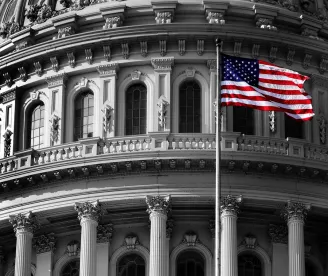We previously blogged here, here, and here about President Biden’s infrastructure plan, first proposed in March 2021. On August 10, 2021, the Senate passed a bipartisan infrastructure bill that included many pieces of President Biden’s plan, but also contained numerous revisions, reflective of the compromises necessary to pass this ambitious legislation in the Senate.
The Senate approved bill scaled down Biden’s infrastructure plan—from $2,600 billion to $550 billion, cutting investments in research and development, clean energy tax credits, public buildings including schools and homes, and home- and community-based care. Here’s what the Senate bill included and what it cut.
Environmental Remediation and Infrastructure
The Senate bill included over $75 billion in allocations for environmental remediation and infrastructure. Notably, the Senate increased spending for environmental remediation and western water infrastructure, the only areas in which it did so. Allocations include:
-
$21 billion in funds for environmental remediation, including funds to clean up Superfund and brownfield sites, reclaim abandoned mine land, and cap orphaned gas wells. The Great Lakes Restoration Initiative—a successful program that fights invasive species, cleans up pollution, and protects the Great Lakes for future generations—will receive $1 billion in funding. The bill aims to create jobs in rural communities that have experienced underdevelopment and remediate sites that have historically affected communities of color at higher rates.
-
$8 billion to improve western water infrastructure, including funds for water storage, rehabilitation of aging infrastructure, rural water projects, water recycling and reuse programs, water desalination research, and other programs to improve access to clean water.
-
$47 billion to upgrade the nation’s infrastructure, including funds for resilience improvement grants, community resilience and evacuation route grants, research, cyber resilience, and transportation, broadband, energy, building, and clean water infrastructure resilience.
Transportation Infrastructure and Safety
The Senate bill also allocated over $250 billion toward transportation infrastructure and safety, including:
-
$110 billion to improve transportation infrastructure, including $40 billion for bridge repair, replacement, and rehabilitation, $16 billion for major projects too large for traditional funding, and reauthorization of the surface transportation program for the next five years. The transportation infrastructure improvements will focus on climate change mitigation, resilience, equity, and safety for all users.
-
$11 billion to fund transportation safety programs, including highway safety, truck safety, and pipeline and hazardous material safety. This includes $5 billion to create the Safe Streets for All program to help reduce crashes and fatalities, especially for cyclists and pedestrians.
-
$39 billion dedicated to modernizing transit, including replacing thousands of transit vehicles with zero emission vehicles, upgrading infrastructure, and improving accessibility for the elderly and people with disabilities. Additionally, the bill dedicates $8 billion in capital investment grants to bring transit services to underserved communities.
-
$66 billion in investment to maintain and modernize railways in the Northeast Corridor, expand rail service to areas outside the Northeast and Mid-Atlantic, and expand high-speed rail. The bill also provides funding for rail improvement and safety grants, as well as crossing safety improvements.
-
$25 billion in funds to improve airport infrastructure and $17 billion to improve waterways and ports. This includes addressing overdue repairs, reducing congestion and emissions, and promoting electrification and other low-carbon technologies to lessen the impact of transportation centers on surrounding communities and improve services.
-
$1 billion to fund the design, planning, demolition, and reconstruction of roads and other infrastructure to reconnect communities that have been separated by or disconnected from transportation infrastructure. According to a White House press release, these communities are typically communities of color. President Biden originally proposed $24 billion for this purpose—so this amounts to a 96 percent reduction.
Utilities Infrastructure
The Senate bill included $185 billion in utilities infrastructure, including:
-
$65 billion to fund nationwide access to high-speed, broadband internet. This adds to the $3.2 billion Emergency Broadband Benefit program launched in May 2021. The funds will make broadband more accessible and affordable by requiring funding recipients to offer affordable plans, creating a permanent program to help low-income households access the internet, and increasing competition.
-
$55 billion to rebuild water infrastructure and improve access to safe, clean drinking water by replacing all lead service lines and removing PFAs. This is the largest investment in clean drinking water in American history, but less than half of President Biden’s $111 billion proposal.
-
$65 billion in investment to upgrade aging power infrastructure including building new, resilient transmission lines to facilitate renewable energy expansion. The bill funds President Biden’s new Grid Deployment Authority, invests in research and development for new transmission, distribution, and smart grid technologies. It also invests in research for nuclear, carbon capture, and clean hydrogen technologies.
Electric Vehicles and Infrastructure
Electric vehicles and infrastructure faced one of the largest cuts while still remaining in the bill. The original bill provided for $142 billion in funding for this category, which negotiations reduced 90 percent to $15 billion in total funding, including:
-
$7.5 billion dedicated to build the first national network of electric vehicle chargers to encourage the purchase of electric vehicles and support manufacturing jobs. This infrastructure project will include placing electric vehicle chargers along highways and within communities, with a focus on rural, disadvantaged communities.
-
$5 billion to replace school buses with zero emission buses and clean buses and to fund charging and fueling infrastructure. Additionally, $2.5 billion is dedicated to purchase electric or low-emitting ferries and to electrify or reduce emissions from existing ferries. This program, if successful, will increase the demand for manufacture of electric batteries and transit vehicles, create jobs, and reduce diesel emissions.
Cut from President Biden’s Proposal
The following funding provisions did not make it into the Senate infrastructure bill:
Research, Development, and Manufacturing
-
President Biden proposed a $566 billion investment in research, development, and manufacturing. As detailed in our previous blog post, Biden’s proposal would have invested in American manufacturing and research and development of decarbonization, carbon capture and storage, hydrogen, reduction of greenhouse gas emissions, advanced nuclear energy, biofuel, bioproducts, quantum computing, offshore wind farming, electric vehicle technology, energy storage, and climate resilience.
-
Additionally, as discussed in our previous post, President Biden’s proposal aimed to promote economic development in low-income communities and communities of color through research and development. The proposal included significant investment to upgrade research infrastructures, create research incubators, and increase research and development in STEM. At least $45 billion was dedicated to Historically Black Colleges and Universities and other Minority Serving Institutions.
Public Benefits and Buildings
-
President Biden’s proposal contained $387 billion in funding for public benefits and buildings. This included $213 billion to build and retrofit over two million affordable homes and commercial buildings; $100 billion for constructing or modernizing public schools; $40 billion to improve public housing; $12 billion for community college infrastructure; and $18 billion for Veterans Affairs hospitals and clinics. Many of these provisions targeted low-income communities and communities of color.
Home- and Community-Based Care
-
The original proposal committed $400 billion in funding for home- and community-based care. These provisions focused on improving access to care for the elderly and disabled and increasing wages for healthcare workers, most of whom are women of color.
Clean Energy Tax Credits
- President Biden’s proposal funded $363 billion in clean energy tax credits; the Senate-approved bill contains none.
Next Steps
The bill proceeded to the House of Representatives. An uphill battle lies ahead: House Democrats have presented a separate $3.5 trillion budget bill, which addresses many of the provisions left out of the Senate infrastructure bill, including provisions for child care, education, healthcare and climate change. It is uncertain which version of the bill the House will vote on.



 />i
/>i

